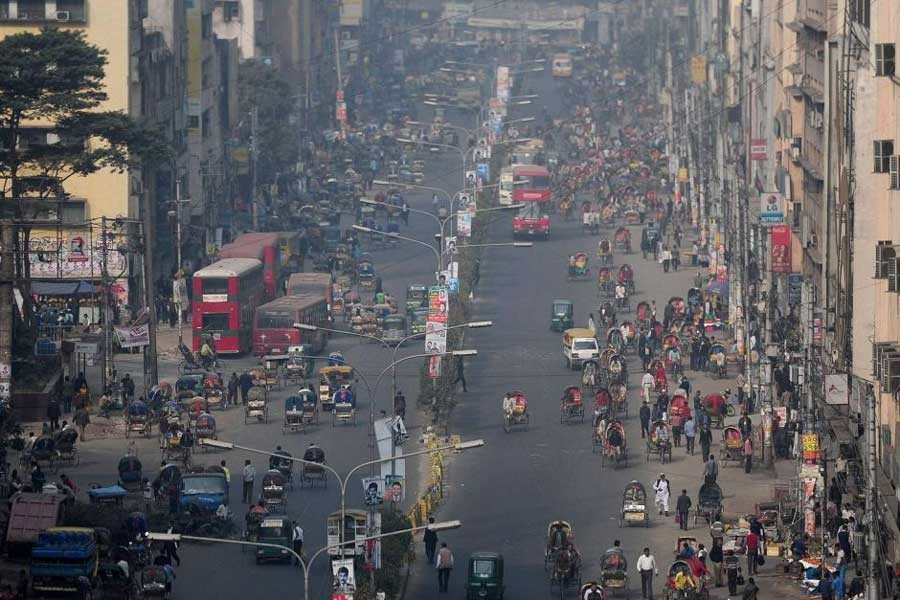A five-year study done by the Department of Environment (DoE) between 2013 and 2018 found that seven cities of Bangladesh-Narayanganj, Dhaka, Gazipur, Rajshahi, Chattogram, Khulna and Barishal-have the most polluted air.
That the study ended four years ago does not mean that the pollution levels have shown any improvement during the intervening period. But what was the reason behind the high level of air pollution in these cities?
The DoE found the brick kilns to be the main source of air pollution of the cities so surveyed. And who does not know that it is the building construction boom in the country that has led to the growth of the brick-making industry?
But we cannot also stop building houses, roads and all other physical infrastructures which are the drivers of the country's economic growth. Then should we have to accept pollution of the air and the environment as a fact of life and suffer the consequences? This brings us to the search for an alternative building material that does not pollute and is sustainable.
However, there is no one-size-fits-all solution to this issue so far. Many green alternatives to bricks are being suggested and are also in use. Those include, among others, concrete block, compressed stabilised earth block, fly ash brick and so on. These alternative construction materials are gaining popularity due to the government's strong position against brick fields.
However, there are also other alternatives considered to be green and energy-saving building materials such as stone, cob (a mixture of clay and straw), bamboo, adobe brick, earth bags, Mycelium (mushroom roots), recycled building materials (waste from landfills recycled as building blocks), earth-packed tires (recycled tires filled with earth bags), upcycled plastic and so on.
But which building material to choose from a range of alternatives depends a lot on the availability of a particular kind of building material in a country, its durability as well as its acceptability in a culture. Affordability is yet another condition that a particular building material has to meet to the satisfaction of its prospective users in a country.
Concrete blocks, though less polluting, may not be as green as other alternatives like stone, cob and other construction materials mentioned in the foregoing. But what is most important is the urge to look for a cheap, eco-friendly and energy-efficient building material.
The building materials that gained popularity in the industrial age, like its most other innovations, have proved to be hostile to environment. So is now the race for finding a universal alternative to bricks and other popular building materials.
While the researchers in their laboratories would be looking for the construction material that suits the changing climatic condition of the world best, the common people, as they have been doing over the millennia, in their effort to adapt will come up with their innovative solutions. And those solutions, though not universal, will be appropriate for their own conditions.
In fact, it is the decentralised approach to building homes, communications infrastructure and other physical facilities for community that holds the answer to the urban dystopia humans have built over the past three centuries.
But before this cutoff point of industrial revolution, the world has been a safer place not only for humans but also for other creatures living on land or in water. The destruction of the environment that started with the energy-guzzling, so-called, industrial era has now driven the humans, nay the entirety of life on the planet earth to the brink.
So, any building concept that encourages centralisation, pollution and wasteful energy use must be discarded. The suggestion does not mean that we should all return to the horse-and-buggy days.
As travelling back in time is not possible, what humans can and should practice is build their civilisation in a new way that can make do with less use of energy. For the way we are generating and using energy is inefficient and irresponsible. Irresponsible because we are burning with reckless abandon what is given in the form of fossil fuels tucked away into the mother earth's womb. Unlike our ancestors, who would replenish the supply of wood and leaves they burnt to produce energy by planting trees, the industrial era people, had no thought of giving back to Nature what they spent by way of burning. The reason was and is that they are yet to develop a technology to produce energy with efficiency.
As a consequence, whatever has been created by this industrial civilisation is inefficient, wasteful and self-destructive. Urbanisation, which is based on wasteful and polluting energy use, is as a result more of a curse than a blessing. Since modern buildings and communications infrastructures lie at the heart of this urbanisation, the materials used to create it cannot be green or environment-friendly.
The hybrid solutions being suggested from time to time whereby polluting and greener alternative can coexist as building materials are but an apology for a meaningful answer to the issue. In truth, the prescription for a gradual transition from the existing polluting to a completely environment-friendly building material towards a green urbanisation is also untenable.
The solution has to be uncompromising and drastic. For we have practically no time in hand to waste.


